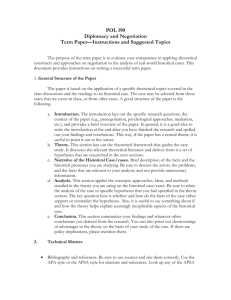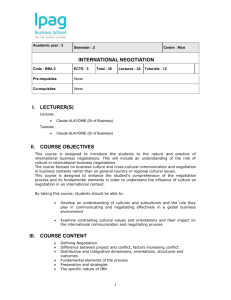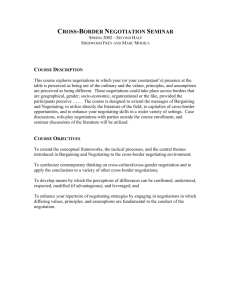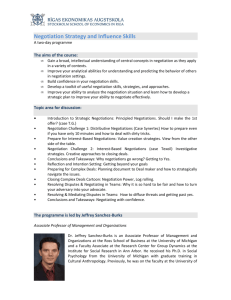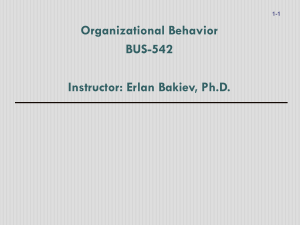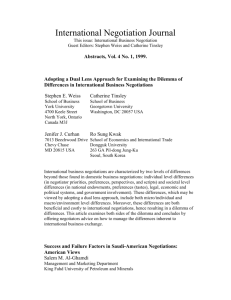Course Introduction
advertisement
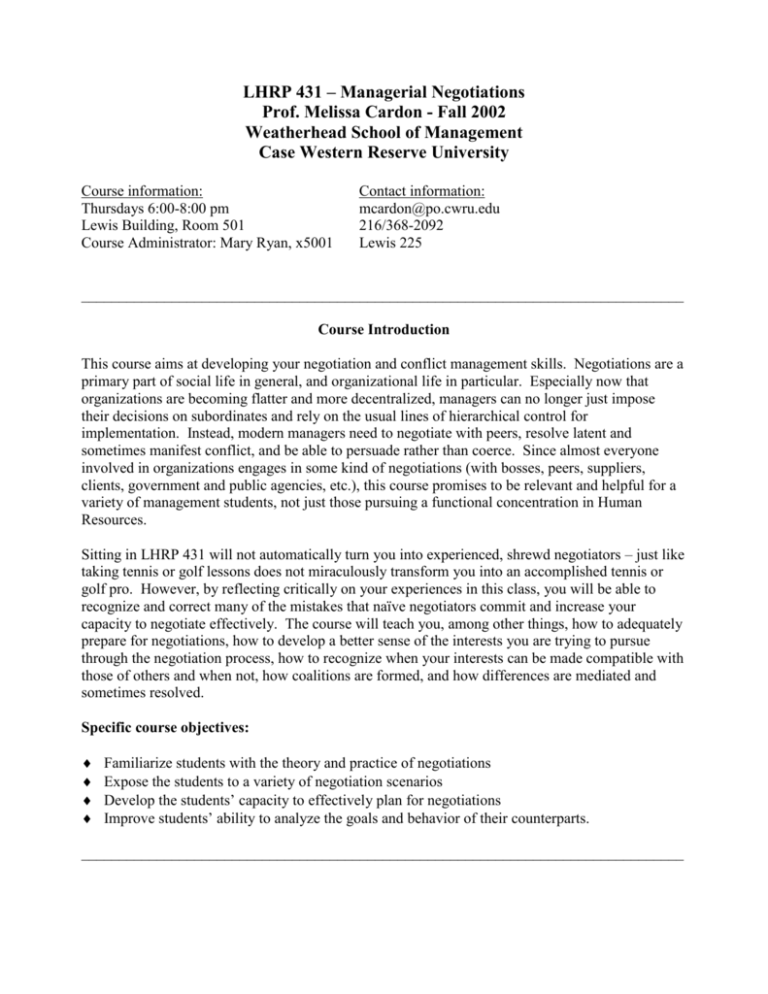
LHRP 431 – Managerial Negotiations Prof. Melissa Cardon - Fall 2002 Weatherhead School of Management Case Western Reserve University Course information: Thursdays 6:00-8:00 pm Lewis Building, Room 501 Course Administrator: Mary Ryan, x5001 Contact information: mcardon@po.cwru.edu 216/368-2092 Lewis 225 ________________________________________________________________________________ Course Introduction This course aims at developing your negotiation and conflict management skills. Negotiations are a primary part of social life in general, and organizational life in particular. Especially now that organizations are becoming flatter and more decentralized, managers can no longer just impose their decisions on subordinates and rely on the usual lines of hierarchical control for implementation. Instead, modern managers need to negotiate with peers, resolve latent and sometimes manifest conflict, and be able to persuade rather than coerce. Since almost everyone involved in organizations engages in some kind of negotiations (with bosses, peers, suppliers, clients, government and public agencies, etc.), this course promises to be relevant and helpful for a variety of management students, not just those pursuing a functional concentration in Human Resources. Sitting in LHRP 431 will not automatically turn you into experienced, shrewd negotiators – just like taking tennis or golf lessons does not miraculously transform you into an accomplished tennis or golf pro. However, by reflecting critically on your experiences in this class, you will be able to recognize and correct many of the mistakes that naïve negotiators commit and increase your capacity to negotiate effectively. The course will teach you, among other things, how to adequately prepare for negotiations, how to develop a better sense of the interests you are trying to pursue through the negotiation process, how to recognize when your interests can be made compatible with those of others and when not, how coalitions are formed, and how differences are mediated and sometimes resolved. Specific course objectives: Familiarize students with the theory and practice of negotiations Expose the students to a variety of negotiation scenarios Develop the students’ capacity to effectively plan for negotiations Improve students’ ability to analyze the goals and behavior of their counterparts. ________________________________________________________________________________ ________________________________________________________________________________ Course Format, Assignments, and Grading This course will operate around a number of simulations combined with debriefs and discussion. Some of the simulations are fairly long, so prompt arrival at class is essential. Some simulation roles will be distributed in advance, and students are required to carefully prepare their roles. Also, students must complete the readings assigned BEFORE CLASS, as these provide theoretical background and practical tips for the experiential exercises. Students will keep a negotiations journal. After each class, write a short (one page or so) entry into your Negotiations Journal. This entry should answer the following questions: 1) What did I learn about negotiations from this simulation? 2) How specifically did at least one concept from the readings apply to this week’s simulation? Be sure to include one passage from the readings from that week or a previous week that you found particularly applicable or descriptive of what occurred in your negotiations. 3) What surprised me about how the negotiations transpired and what helps explain the previously unanticipated developments? 4) The basics of the negotiation (simulation name, your role, and your negotiation partners) should also be noted. All journals with weekly entries should be submitted by November 21st. For three of these simulations (your choice), prepare longer written critiques/analyses after the exercise. These write-ups should be 3-4 pages long, double-spaced, with one-inch margins. A suggested format for analyses is attached to this syllabus. Each analysis is due at the beginning of the class following the simulation you are analyzing. Each student is also required to write a Final Negotiation Analysis paper (10-15 pages) based on a negotiation episode in which the student has been directly involved or that he/she has closely observed. General guidelines for the Final Negotiation Analysis are attached to this syllabus. Written assignments are due at the beginning of class. Any papers received after this point will be considered late. Late papers will lose 10% of the received grade for each day late up to two days at which point the papers will not be accepted. The weighting of assignments in determining grades will be as follows: Analysis 1 10% Analysis 2 10% Analysis 3 10% Class Participation 30% Negotiations Journal 20% Final Negotiation Analysis Paper 20% ________________________________________________________________________________ ________________________________________________________________________________ Note on Attendance and Preparation This class requires personal participation and involvement as key ingredients. A great deal of learning in this class will come from critical reflection of one’s own and others’ experiences. Class participation is measured by quality (rather than quantity) or your comments. It also includes professional behavior in your interactions with colleagues and the instructor. Some of the exercises are quite fun. However, they are not intended as pure games; their purpose is learning and experimenting with new approaches to negotiation. Please take your simulation roles seriously and do not be unduly frivolous in class. Different from other courses, in which absences only impact the learning process of the individual student, unexpected absences of lack of adequate preparation in this course damage other class members as well. Therefore, the attendance policy in LHRP 431 is quite strict: unless the instructor is notified by 12 noon of the class date, and the absence is for a bona fide legitimate reason, the absent student will be assessed a five point penalty against his/her grade. Legitimate reasons for missing class do NOT include getting stuck at work late or caught in traffic. Class starts at 6pm, so plan accordingly. Please note this penalty will be assessed whether you have a good reason, bad reason, or no reason at all for missing the class. Late arrivals (affecting the formation of groups for simulations) or lack of preparation count as unexcused absences. In case timely notice of legitimate absence is provided and a suitable replacement found, no penalty will be assessed. However, the student’s class participation grade will suffer and is likely to decrease. Students who expect to miss more than two classes over the course of the semester should contact the instructor before the end of the drop/add period. Further, simple attendance at class and participation in the simulations does not guarantee you an A for participation in this course. Instead, we will together evaluate your in-class oral contributions at the end of every class meeting time. At the end of each class, you should assign yourself a grade based on the nine-point system outlined below. At any time you wish you determine your participation grade, you can average the weekly grades. It truly is your responsibility to be prepared and involved in the class, so please don’t come to me at the end of the semester to inform me that you did not participate because I did not call on you or that you were listening intently to every word that was spoken. Nine-point Participation/Contribution Scale: 9 = A+ Exceptional. Quality and quantity of contributions were all on target and beyond what is expected, but not excessive. Really challenged our thinking. 8 = A Excellent. Multiple contributions that were fairly significant in defining issue and to keep discussion going/creating new lines of discussion. Above normal expectations. 7 = A- Very Good performance. Well prepared, identified one or two key issues, initiated an issue and/or made a significant contribution to sustain a discussion. 6 = B+ Good performance. Demonstrated good preparation, grasped key issues, made several contributions and sustained discussion. 5 = B Better than average. Adequately prepared, made at least one meaningful contribution that showed a knowledge and gasp of what the issue was about. 4 = B- Average performance. Minor contributions, seemed to know key words/concepts, but didn’t get into any content or issues. Preparation not confirmed. 3 = C+ Below average performance. Made occasional/minor contributions, appeared to follow discussion/questions. Preparation not confirmed, but seemed unprepared. 2 = C Well below average. Some performance deficiencies. Appeared unprepared, not alert to what was going on, or made no contributions or poor ones. 1 = C- Deficient. No performance indicators. Present, but made no contributions and did not appear prepared, or contributions were incorrect of “off the mark”. 0 Absent without prior notification ABS Excused absence Characteristics of effective contributions: The points made are relevant to the discussion in terms of increasing everyone’s understanding and not just a regurgitation of facts. The comments reflect understanding of relevant concepts from the assigned reading and other materials from the course. The comments take into consideration the ideas offered by others earlier. They build on what has been stated before. (The best contributions tend to be those which reflect not only excellent preparation, but good integrative skills as well.) The comments show evidence of a thorough reading and analysis of the assignment. The contributor is willing to interact with other class members by asking questions and challenging conclusions. The contributor responds directly to the question asked, to the issue on the “floor”, rather than to his/her own agenda. ________________________________________________________________________________ Class Schedule: Date Topic Aug 29 Introductions Sept 5 Preparing for Negotiations Sept 12 Distributive Solutions Readings Simulation LSM 1 Salty Dog R 1-1 LSM 2 (p 40-69 ) TexOil R 1-3; 2-2; 2-3 LSM 3 R 3-2; Buying a New House 3-3 Sept 19 Integrative/Mixed-Motive Bargaining LSM 4 Universal Computer (I) Sept 26 Negotiation Styles; Individual Differences - Influence Tactics Inventory Due - LSM 10 R 10-1; 10-2 Salary Negotiations Oct 3 Communication, Perception, Biases - SINS Assessment Due - LSM 5 Bestbooks/Paige Turner Oct 10 Finding and Using Leverage LSM 6 Power Game Oct 17 Can You Negotiate Ethically and Still Win? LSM 7 Bullard Houses Oct 24 Social Context of Negotiations LSM 8 Jordan Electronics School Dispute (9) Oct 31 Multiparty Negotiations; Coalitions LSM 9 Coalition Bargaining Nov 7 Global Negotiations LSM 11 Alpha-Beta (17)/ Sick Leave (26) LSM 12 Elmwood Hospital (11)/ Third-Party Conflict (15) Nov 14 Managing Difficult Negotiations Nov 21 Failure of Negotiations - NEGOGIATIONS JOURNAL DUE Nov 28 THANKSGIVING Pacific Oil Company Case Dec 5 The Playground Negotiation (23) Course Wrap-up – FINAL PAPER DUE – APPENDIX I Personal Negotiations Journal Suggestions The purpose of the negotiations journal is to reflect and analyze the ‘learning by experience’ simulations. The journal also gives the instructor a sense of your individual progress, and your strengths and weaknesses as a negotiator. Your task in this journal is to describe your reactions, perceptions, impressions, or significant insights gained from participation in or reflection on the simulation. You may talk about yourself or the behavior of other people, or may want to address some or all of the following points: Overview of key events What did you learn about yourself from this experience? What did you learn about the behavior of others from this experience? How does this experience compare to others that you have had in similar or comparable circumstances? What did you learn about bargaining or conflict from this situation? How do the concepts in lectures or readings enrich your understanding of the process of negotiation, its outcome or your own negotiation style? What would you do the same or do differently in the future, or how would you like to behave in order to perform more effectively? Please note that you are NOT expected to explicitly answer each of these questions every week. Instead, the negotiation journal should reflect the important aspects of the negotiation simulation as you see them. I do not anticipate receiving neatly typed, closely edited papers for this part of your course grade, but rather your free-form stream of consciousness as you plan for, engage in, or reflect upon each simulation. I STRONGLY encourage you to make your journal entries closely after each simulation, when your thoughts, impressions, and ideas are fresh and most meaningful. APPENDIX II Negotiation Simulation Analyses Background Each Report/Critique should be 4-5 pages, double-spaced, with adequate margins for instructor comment. In simulations where you had more than two parties involved, the critiques will be a bit longer. Please begin each critique with the following: A. What was the name of this simulation? B. Who was (were) the other participants in the simulation? For each of the other participants, evaluate his/her preparation for this simulation where: 0 = about as well prepared as you expected; +1 = better prepared than you expected; -1 = less well prepared than you expected. C. Briefly summarize your settlement. Suggested Outline for Simulation Critiques The objective of the critique is to encourage your systematic thinking about how the concepts developed in this course (class discussion and readings) were put to use (or not put to use) in your experience. Any critique that provides evidence of such systematic thinking will be acceptable. Note that the converse is also true. A critique that merely describes what happened will be unacceptable. Analysis of the events in terms of the concepts developed in class and in the reading is essential. Bottom Line Analysis 1. What was your “BATNA” for this simulation? What was your “bottom line” – the minimum you would have accepted from the other party (in concrete terms)? At what point in the negotiations (if ever) did you make clear, or "come clean" about your bottom line? Did you ever reveal completely your "bottom line"? (In negotiations with multiple team members, or in multiparty negotiations, be sure to include all participants as "other parties".) 2. What were the BATNAs of all other participants in your negotiations, if you know? How did you know this, if you did? What was each of the other parties’ bottom lines – the minimum that the other party (or parties) wanted you to do (in concrete terms)? How did the other party make this clear to you? When did it become clear – early, middle, later part of negotiation session? Describe how other party came to tell you what he/she wanted, e.g., it was openly stated up front; you were able to infer it from other comments, etc. (Again, consider all participants as "other parties".) Interests 3. What were your objectives (interests)? How did the other party's "position" (above) conflict with your interests? That is, why couldn't you do what the other party wanted? 4. What were the other party's interests? Why did your position conflict with the other party's interests? Objective criteria 5. Did either party attempt to interject objective standards or criteria as a basis for determining the outcome? What were they? What effect did they have? If such criteria were interjected, was the response (a) to show how such criteria were not relevant to the instant dispute; (b) to interject other criteria with implications contrary to the first set; (c) an open discussion of how to make the criteria acceptable to all parties; (d) all of the above? Discuss. Be sure to indicate whether you thought the criteria were merely a subterfuge to obtain a bargaining advantage, or truly an effort at integrative bargaining or a “fair” outcome, and why you thought so. Multiple issue negotiations 6. There will almost always be more than one issue in your negotiations. Was an explicit understanding reached about what the specific issues were? Did the parties try to deal with the issues one at a time? Were they settled one at a time; all at once; or in several "packages"? Discuss how the packages were developed. Intangibles 7. Describe any "commitment" behavior by you or the other party in your negotiations. (See LSM. Commitment behavior is an action that suggests a party is taking a strong stand on a particular position. "If you can't do 'X', I don't believe we can do business with each other," would be a strong commitment statement.) What was opponent's reaction to the commitment behavior: (a) concession; (b) an equal and opposite commitment; (c) ignoring the commitment; (d) other? 8. To what extent was "face saving" necessary in your negotiations? What created the need for it – something in the context of the case description, or something that happened during the negotiations themselves? Describe any "face saving" behavior. Other relevant considerations The above outline is not intended to constrain your analysis. Please develop any other ideas you have that are related to the reading and class discussions. APPENDIX III Final Paper Suggestions The final paper assignment is to describe and analyze the negotiation of a conflict situation in which the student has been involved either as a participant or eyewitness. A paper of 15-20 pages should be sufficient to (a) describe the event and (b) demonstrate to the reader the level of your understanding of course concepts. An alternative assignment is to plan for, negotiate, then analyze a negotiation during the semester. This paper would incorporate how you planned for the negotiation, execution of the negotiation, report of results, post-hoc interviews with other participants, and analysis, integrating theory, models, and other course materials. This might include negotiating grade changes, resolving conflicts with roommates, negotiating a new job assignment, buying cars, or any other significant negotiation that has personal value to you. A suggested approach is to completely describe all the relevant facts in no more than five pages. (If description does not take at least three pages, the event is probably not of sufficient complexity for this assignment.) Then develop your analysis. Such an approach will assure adequate attention to the analytical portion of the paper, which will form the basis for its evaluation. As with the Analyses, a description alone is not sufficient. It must be analyzed using terms developed in this course. The following elements should be considered in most instances although this suggested list should not be taken to be entirely prescriptive. Unique circumstances may dictate an alternative approach to the paper. 1. Source of difference. a. The difference or "conflict" must be bona fide, not just a misunderstanding. b. When and how did you become aware of the difference? c. When did the opponent become aware? d. Describe the respective "interests" of you and the opponent. 2. Initiation of negotiation a. Background on any relevant events before negotiations began. b. Who initiated action leading to initial discussions? c. Describe the circumstances of the initial meeting. d. What were the initial stated positions of you; your opponent? e. If your "bottom line" position was different at the time, what was it? f. If you suspect your opponent's "bottom line" position was different at the time negotiations began, what do you think it was? 3. Alternatives a. Describe any alternatives you had to negotiating with your opponent including your best alternative to a negotiated agreement. b. Do the same for your opponent. 4. "Bars to Agreement" a. b. c. Review the concepts that Carl Stevens labels "bars to agreement" as discussed in class. (LAWS 351 students: you may omit this element or ask P. Gerhart for a special handout not included in the syllabus for 351.) During the pre-agreement period, what "bars to agreement" did you actually experience? What steps did you, your opponent, or someone else take to overcome them? Refer to Stevens' discussion of these actions. 5. Power vs "Reason" a. Discuss any source of power available to you and your opponent and the extent to which it was used. b. Discuss the "rationale" used by you and your opponent, if any. 6. Distributive/Integrative Elements (Creating/Claiming Value) a. Describe the distributive elements (claiming behavior) in the dispute. b. Discuss any effort by you or your opponent to discover integrative solutions (create valve). 7. Outcome Explain the outcome and how the above elements helped to shape it. 8. Evaluation If you had it to do all over, knowing what you now do, would you have done anything differently? What and why?


